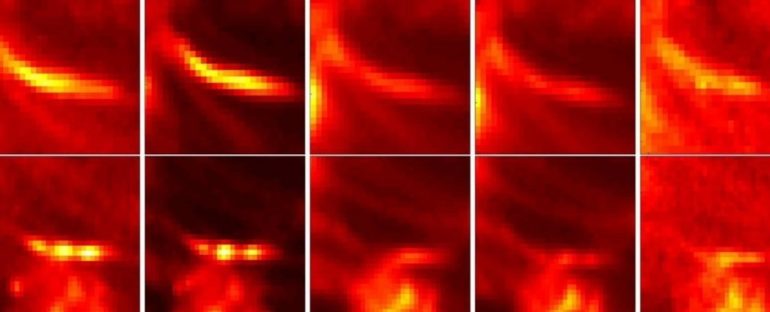When Shah Bahauddin was deciding what to research for his PhD, he had no intention of becoming embroiled in one of the most vexing problems in astrophysics: why is the Sun’s distant atmosphere so much hotter than it’s roiling surface?
His modest topic of choice was a tiny and brief loop of solar light, barely detectable considering the grand scheme of the Sun.
But size isn’t everything. As it turns out, astronomers had been looking for a tiny eruption just like this one for more than half a century.
Flickering just below the Sun’s super-hot corona, the explosion Bahauddin stumbled upon may very well be the first complete glimpse of a solar ‘nanoflare’ – from its sudden bright beginning to its inevitable sizzling demise. And we could just as easily have missed it.
If subtle and fleeting loops like this are a frequent affair, it could help explain how the Sun’s corona came to be hundreds of times hotter than its visible surface – a mystery known as the coronal heating problem.
“I thought maybe the loops made the surrounding atmosphere a bit hotter,” admits Bahauddin.
“I never thought that it would make so much energy that it might actually propel hot plasma to the corona and heat it up.”
Loop brightenings observed. (Bahauddin et al., Nature Astronomy, 2020)
A billion times smaller than regular solar flares, nanoflares are incredibly difficult to spot and have only ever existed in theory, so the researchers are still reluctant to call the discovery by that official name.
In theory, we have an idea of what a nanoflare should look like, but that’s based on several assumptions.
“Nobody actually knows because nobody has seen it before,” Bahauddin says. “It’s an educated guess, let’s say.”
Ever since astrophysicist Eugene Parker first proposed the idea of nanoflares in the 1970s, experts have been trying to figure out what these eruptions might look like in reality.
If they really do exist, they are nearly impossible to see, occurring millions of times a second without our instruments ever noticing. Although our technology is getting better.
In 2017, for instance, our best glimpse of a nanoflare came from the absence of a bigger one. An active region in the Sun, which hosted very few normal-sized flares, showed a curious level of heating. Something unseen clearly had to be contributing energy to the atmosphere. A nanoflare suited the case.
Technically, to be deemed a proper nanoflare, a blast of heat must be triggered by the Sun’s tangled magnetic fields, which are produced by bubbles of churning plasma below.
When these fields reconnect, they are thought to cause an explosive process – equivalent to around 10 billion tonnes of TNT. This energises and accelerates surrounding particles, and if all that activity is strong enough to heat the Sun’s corona, thousands of kilometres above, it’s called a nanoflare.

Above: A close-up of one of the loop brightenings studied. Each inset frame zooms in further (from left to right), showing the putative nanoflare.
Analysing some of the finest images of the Sun’s corona, taken from NASA’s Interface Region Imaging Spectrograph, or IRIS satellite, the new discovery ticks both those boxes.
Not only was this tiny loop of light millions of degrees hotter than its surroundings, the way it erupted appeared curious.
“You have to examine if the energy from a nanoflare can be dissipated in the corona,” explains Bahauddin.
“If the energy goes somewhere else, that doesn’t solve the coronal heating problem.”
Looking at the data, it appeared that heavy elements, like silicon, became much hotter and more energetic than lighter elements like oxygen, which is exactly the opposite of what you’d expect.
Searching for a type of heat that could impact an oxygen atom differently to a silicon atom in just that way, researchers found only one match: a magnetic reconnection event.
Under these complex chaotic circumstances, heavier ions have an advantage, because they can plow through the crowds of lighter ions and steal all the energy, accruing great heat in the process.
But that was only a hypothesis, and it seemed like a long shot. The conditions needed to achieve this type of heating required just the right proportion of silicon to oxygen. Could that really exist?
“So we looked back at the measurements, and saw that the numbers exactly matched,” explains Bahauddin.
To the team’s astonishment, it appeared they had stumbled upon a real explanation for coronal heating. The next step was to see if it actually heated the corona.
Analysing data from the region right above the bright loop, just before it flared, the team discovered their final clue.
“And there it was, just a 20-second delay,” recalls Bahauddin. “We saw the brightening, and then we suddenly saw the corona got super-heated to multi-million degree temperatures.”
Already, the team has found nine other loops on the surface of the Sun that also show a similar transfer of energy to the corona.
Whether this localised heating is enough to explain the higher temperatures found across the Sun’s corona will depend on how many other loops astronomers can find.
If their frequency and locations are often and widespread enough, these bursts of energy could at least partially answer the mystery surrounding coronal heating.
Yet in all likelihood, astronomers think there are probably multiple invisible mechanisms at play. It’s probably not just one thing that is heating the Sun’s atmosphere to such blistering temperatures, and many of the ideas we have now are not mutually exclusive.
Other theories include electromagnetic waves washing outwards from the Sun, heating particles and allowing them to ‘surf’ to the outer atmosphere.
This little loop is just one tiny piece of the puzzle.
The study was published in Nature Astronomy.



